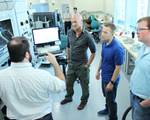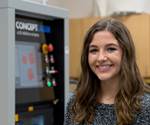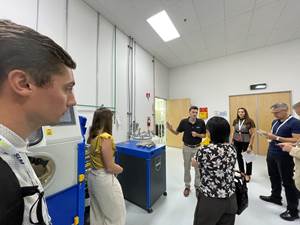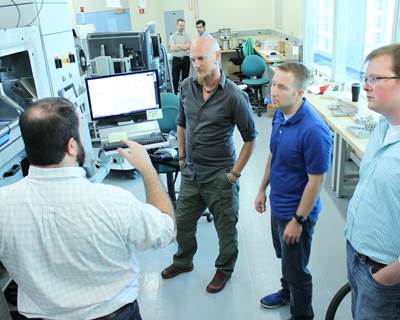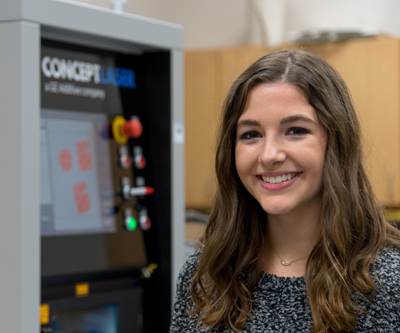Closing Additive Manufacturing’s Skills Gap
Cincinnati State’s new additive manufacturing certificate program offers a lesson in workforce need versus availability.
Most who dwell within additive manufacturing’s orbit know that each day brings news that cracks the ceiling of what is possible with AM. But behind each unveiling of a new additive machine or advancement of a new AM process, there lies a dilemma for manufacturers that becomes inversely more problematic. It is the widening gap between the need for an AM-trained workforce and the availability of skilled workers to fill existing AM roles. This gap between need and availability is both a contemporary problem and one that will hobble additive manufacturing industries for years to come.
This is why the news of a local two-year technical college’s new, 270-hour additive manufacturing certificate program is worth examining. Simply put, Cincinnati State’s new Additive Technician Training Program is likely to be more pragmatically relevant to the average manufacturer than the latest nanocomposite powder or $1 million quad-laser machine hitting the market. And for regional employers in the additive space—which in Cincinnati includes Fortune 50 companies and industry giants such as GE and P&G—the formation of Cincinnati State’s Additive Certification Program is nothing less than critical.
“Every single one of our industry partners who are hiring for these positions are hiring people with no training,” says Jeremy Jarrett, senior vice president of Kinetic Vision and chair of the technical advisory committee responsible for developing the additive technician program curriculum. “They basically hire for a set of intangible skills—a great ability to communicate, a high comfort level with technology, and so on. But no one that they’re hiring for these additive technician positions has any training, because there is no training available.”
Dig a bit deeper into this problem, and you’ll find its roots spread across the entire manufacturing landscape. According to recent figures from the Bureau of Labor Statistics, manufacturing employs about 12.5 million workers in the U.S., with as many as 600,000 technical manufacturing jobs unfilled. Take into account that, according to the U.S. Census Bureau, more than 20 percent of the entire U.S. population will be age 65 or over by the year 2029—opposed to just 13 percent in 2010—and the threat level of manufacturing’s so-called “skills gap” becomes crystal clear. Then consider the projected growth of AM over five, 10 and 20 years, and suddenly you have reason to feel nervous if you’re a hiring manager for a manufacturing company hoping to grow your AM operations.
The Birth of a Program
With this in mind, it should be no surprise that the seed for CS’s new additive certificate program was, in part, planted when GE Aviation—highly invested in additive manufacturing—announced an expansion and revamping of its Evendale, Ohio, headquarters in 2014. The $200 million revitalization project involved a public-private partnership that included tax credits from the state and a grant from the city. (Here we should note that Evendale is considered a village, not a city. No angry tweets, please.) The announcement also kicked off a development project called Aerohub, which was formed to serve as an advanced manufacturing and aerospace accelerator for the region. Aerohub began purchasing nearby parcels of land with the goal of creating an “innovation ecosystem for advanced manufacturing” with a specific focus on an additive manufacturing and aerospace.
Amy Waldbillig, Cincinnati State’s vice president of the Workforce Development Center, says that it was during this period when Evendale’s mayor, Richard Finan, reached out to Cincinnati State to discuss how regional manufacturers could capitalize on additive manufacturing’s growing footprint, as well as support businesses like GE who rely on it. But Waldbillig says that it wasn’t only GE that was driving the momentum. “At the same time when the real estate purchases were moving along, there was a sprout of other businesses like Tangible Solutions, Beam Machines and Simplify3D that were really starting to take off. P&G was becoming more active with additive. Cincinnati State began to notice an immediate need for workforce.”
But the bridge between the industry’s need for a workforce trained in the rapidly changing, highly varied field of AM, to a curated, industry-certified course of higher-ed training that satisfies that need, can be long and tenuous. Business and educational institutions measure time in cosmically different ways, and if Cincinnati State was to pull this program off in a manner that satisfied industry, it would have to “work at the speed of business,” Waldbillig says.
In 2015, it was collectively decided that a technical advisory committee should navigate the curriculum creation process. The committee, which launched through Aerohub and is composed of 25 members, features a who’s-who list of manufacturing powerhouses. First chaired by Greg Morris, leader of additive technologies for GE Aviation, the list includes representatives from P&G, Edison Welding Institute, Cincinnati Inc., America Makes, Tangible Solutions, the Rhinestahl Corp., and numerous others. The committee meets twice a month to manage what is essentially a dual task: to assist companies that are trying to enter the additive and aerospace markets within the region, and to help develop the curriculum for the additive manufacturing training program soon to be offered by Cincinnati State.
Progress has been swift. This past September, Cincinnati State announced that it had received a $393,000 grant from the federally-funded LIFT Institute to develop its additive training program. Between private, federal and state dollars, the LIFT grant brought the total funding for the AM program to $1.8 million. In addition, with five months to go until launch, a curriculum design concept that includes both classroom and operational training is well underway. Courses descriptions include topics such as process data flow and file types, optimal orientation of parts, calibration of additive manufacturing equipment, principles and concepts of statistical quality control, safety, material science and tolerances, design of 3D-printed parts, and numerous other subjects.
“We don’t have a $500,000 metal AM machine, but when our students leave here, they will know about additive technologies."
Dr. Mike Devore, professor and program chair of Cincinnati State’s mechanical engineering technology department, says that it is the agility of technical and community colleges that allows them to react to industry needs so rapidly. “The biggest thing is that we are very flexible and we move quickly,” he says. “We’re constantly in contact with employers who hire our co-ops and our graduates. We are able to do things much more rapidly than large universities.” (To wit: When the need arose to widen the door between two of Cincinnati State’s machine shop labs, DeVore, who at age 64 has been with the college for 27 years, bypassed typical higher-ed red tape and simply cut a semi-truck-sized opening in the wall himself.)
While metal AM will compose part of the new program’s curriculum, DeVore says that training may take place remotely at one of the college’s industry partners. As things stand today, Cincinnati State has a total of eight FDM machines, from a Makerbot, to Ultimakers, to larger machines from 3D Systems. A wish list may include a metal machine, but DeVore says that students will be well prepared across a wide spectrum of fundamental AM knowledge. With the program set to launch in April of 2018, Cincinnati State aims to provide training in the operation of additive manufacturing equipment and prepare AM technicians and future engineers through hands-on training and class courses. Graduation will require sufficient mastery of AM processes from CAD modeling through the creation of a finished part.
“We don’t have a $500,000 metal AM machine,” DeVore says, “but when our students leave here, they will know about additive technologies. They will be able to co-op and use that equipment, and we will set them up so they can go out and do that. We are always trying to hit a moving target and we’re happy to chase it because that’s what allows us to teach our students what is relevant. We have all of the pieces; now we just have to put them together.”
With five months until the first graduating class of Cincinnati State’s additive certificate program steps onto campus, Jeremy Jarret has no doubt: Graduates will find work regardless of whether they decide to continue their education or seek immediate employment. “They are going to be placed 100 percent of the time,” he says. “Every single one of our industry partners is talking about having to hire 18-year-old kids who are good at video games because they don’t have any other skills. I think this is us coming back to the days of apprenticeships, where people could get into a trade and learn a skill that’s in high demand. We’re going to be teaching a skilled trade, but teaching it on a platform that is incredibly high tech. Our biggest concern will be keeping up with demand.”
Related Content
How to Organize for Additive Production: AM Radio #42
Tim Simpson and Peter Zelinski discuss the next steps for succeeding with AM: After technical and process successes come the cultural, organizational and even costing considerations associated with this mode of manufacturing.
Read MoreVideo: Intelligent Layering Metal 3D Printing at 3DEO
Contract manufacturer 3DEO delivers metal parts using Intelligent Layering, a binder jetting-like 3D printing process the company developed and operates internally. Here’s how it works.
Read More3MF File Format for Additive Manufacturing: More Than Geometry
The file format offers a less data-intensive way of recording part geometry, as well as details about build preparation, material, process and more.
Read MoreThe AM Ecosystem, User Journeys and More from Formnext Forum Austin: AM Radio #43
Sessions and conversations at the first U.S. Formnext event highlighted the complete additive manufacturing ecosystem, sustainability, the importance of customer education, AM user journeys and much more.
Read MoreRead Next
Inside the Penn State Additive Manufacturing Master’s Program, Part 1
PSU's engineering master's degree in additive manufacturing and design offers students and manufacturing professionals a higher education in a continuously maturing field.
Read MoreAuburn University's Roadmap to Additive Manufacturing Education
As additive manufacturing workforce needs grow and AM technologies evolve, what does a higher-ed additive program look like? Is additive manufacturing a college major, minor or something else?
Read MoreAlquist 3D Looks Toward a Carbon-Sequestering Future with 3D Printed Infrastructure
The Colorado startup aims to reduce the carbon footprint of new buildings, homes and city infrastructure with robotic 3D printing and a specialized geopolymer material.
Read More



